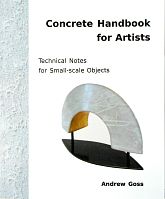Homepage
How To:
Technical
Guest Gallery:
Concrete Artists
Andrew Goss:
Concrete Work
Concrete Handbook
for Artists
Details
Feedback
Update
Order book?
—U.S.
—Canadian
—U.K.
—Overseas
—PDF Download
SITE MAP
Concrete Handbook for Artists
Technical Notes for Small-scale Objects
UPDATE
 If you are a purchaser of this book, previous to April, 2006, then here are some updates to the original printing (2002). The book has been updated with a few changes in April, 2006, so what this page is trying to do is let you know what those changes are.
If you are a purchaser of this book, previous to April, 2006, then here are some updates to the original printing (2002). The book has been updated with a few changes in April, 2006, so what this page is trying to do is let you know what those changes are.
Some of these changes may have been noted in a letter sent out with the book.
BOOKS:
Check the books page on this site for current titles. Sherri Warner Hunter has published another book through Lark Books, Creative Concrete Ornaments for the Garden : Making Pots, Planters, Birdbaths, Sculpture & More. Several images of my own own are in the book, along with a series of photographs explaining a sculpture process. Her earlier book in my bibliography (p. 112) Creating with Concrete has been reprinted as Making Concrete Garden Ornaments and is also published by Lark Books. Another book I highly recommend is Design and Control of Concrete Mixtures published by the Portland Cement Association - both in Canada and the U.S.A. It's an excellent technical reference with a new focus on supplementary materials, fibres and light weight mixtures. I also recommend both Concrete at Home (2005) and Concrete Countertops (2002) by Fu-Tung Cheng, published by Taunton Press. They have good solid technical information and a lot of the methods can be applied to artwork and sculpture.
LATEX OR ACRYLIC:
In the book I suggest using latex or acrylic solutions (bonding agents) in place of water. I still strongly recommend this, particularly in smaller work and where you can afford it in larger pieces. In my own work I have switched almost completely to acrylic admixture (sometimes called acrylic polymer, or acrylic cement additive). In small work do not dilute it with water at all. I find it stronger than the latex, has less of an odour, and is now easier to source. Home Depot in Canada and the U.S.A. carry it. One caveat: it seems the latex or acrylic additives may negate the advantages of using metakaolin, weakening the bond between it and the cement particles. If using acrylic or latex you may as well use the less expensive fibres, like nylon.
METAKAOLIN:
A new source for metakaolin in the U.S.A. is http://www.concretecountertopinstitute.com. Look for "products", click on it, then look for "Metakaolin." The Concrete Countertop Institute sells individual bags (40 lbs). You don't have to buy a truckload any more. You can also buy smaller quantities from concretedepot.net.
SEALERS:
In addition to what I have written in the book, the main thing to look for is that the sealer penetrates and does not discolour the concrete. A good water-based non-acrylic sealer (potasium silicate or sodium silicate) should penetrate 1/4" (5mm) or more. Acrylic sealers will not penetrate and will often discolour. I've found the sealers labelled as silanes and siloxanes good and they penetrate well, but those containing potassium silicate or sodium silicate the best. Often the labels on these types do not say what they are, but if they are water-based, and described as "penetrating", and will "increase density", they are what you need. I've added a couple of links on the links page for some mail-order sources. Look in the Suppliers section. As a glossy final finish and waterproofing (particularly for jewellery) I use a carnauba wax. Hardware stores used to carry this, but until recently I have only found brands that have carnauba added in small quantities. Try Lee Valley Tools for their Blue Label paste wax: http://www.leevalley.com/.
LIGHTWEIGHT AGGREGATES:
In the lightweight aggregates section of the book, I added several new materials.
-- Pumice (a volcanic glass rock that is very porous) is very similar to perlite.
-- Glass spheres, sometimes called macrospheres, are hollow, BB sized or smaller, and available from Douglas & Sturgess in San Francisco at artstuf.com.
-- B-Lite® is a brand of polystyrene beads that are coated to aid in mixing into concrete. You can easily make a lightweight, carvable concrete with this aggregate. B-Lite sells large boxes (2 ft cubed), so shipping can be expensive from Arizona.
PVA or POLYVINYL ALCOHOL FIBRES:
PVA fibres (polyvinyl alcohol) are a recently developed fibre additive which gives much greater tensile strength than polypropylene or nylon. There is an actual molecular (rather than mechanical) bond with the cement. My own early test results are extremely promising. Recent scientific tests show three times the tensile strength of other plastic fibres due to the bond between the fibre and the cement particles. But one caveat: PVA fibres may not develop their full strength when used with acrylic or latex additives, so just use water as the liquid (along with a superplasticizer or water reducer). They are available through Nycon (www.nycon.com for contact information) in the USA and now from concretedepot.net.
You might be interested in joining an email discussion list I started called ArtConcrete. It's a good place to ask questions. There are over 80 subscribers. More info?
Recently I have been mailing out some workshop notes, two pages, with the book. If you did not get that mailed with your book, you can print out ther PDF file here.
As always, I enjoy hearing from other artists and workers in concrete, with your ideas, questions and suggestions. Follow the contact link below.
~Andrew Goss
CONTACT + LEGAL
Andrew Goss
26 Clarke Street East, Guelph, ON, N1H 1S7
Tel: 519.265.4057

Paypal Verfified Business